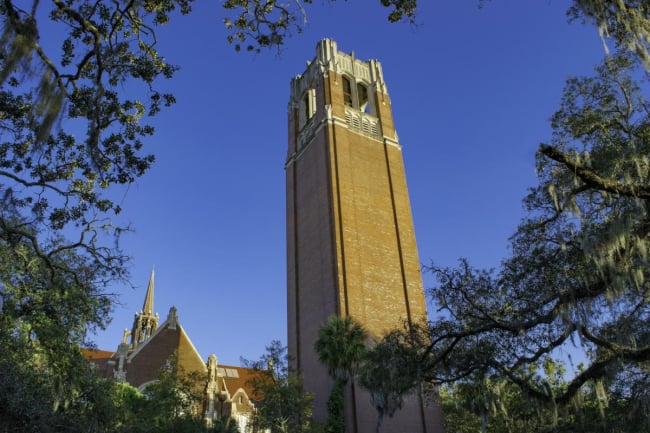You have /5 articles left.
Sign up for a free account or log in.

Three professors at the University of Florida were refused permission to testify in court proceedings against new voting laws supported by Governor Ron DeSantis and the state Legislature.
Michael Warren/iStock/Getty Images Plus
For much of the past century, institutions of higher education have been described—and often derided—as ivory towers, detached from practical concerns. In reality, colleges and universities have always been enmeshed in issues facing the broader society. During the pandemic, interconnections with, dependence on and sometimes interference from federal, state and local governments and agencies have grown substantially.
The implications for the future are significant, because while the pandemic may recede, political interference is likely to accelerate.
After most colleges and universities shifted to remote instruction in March 2020, many states issued detailed requirements for reopening. Along with general requirements for employees’ return to offices, for example, New York set out higher education–specific rules on physical distancing, protective equipment, hygiene, cleaning and disinfection, communication, and health screening. Colleges and universities had to submit reopening plans meeting state standards before resuming in-person instruction, and then they had to adapt to constantly changing requirements on everything from isolation and quarantine rules to the size of gatherings.
Colleges and universities have worked closely with county health departments to manage case numbers and limit outbreaks, often including detailed discussions of room volumes, air refresh rates and quarantine protocols. When coronavirus cases swamped the capacity of local health departments to conduct contact tracing, many colleges and universities implemented their own tracing programs. Some also partnered with local officials on wastewater testing and, in one case, piloted a shortened isolation program. Still other institutions made their testing and vaccination sites available to their local communities and housed medical personnel or individuals needing medical services.
University research has been indispensable in informing the public health response to COVID-19, and, of course, university training has equipped scientists, doctors and other health-care personnel who are developing COVID-19 vaccines and treatments and assisting those who fall ill. University experts also provide much of the data, expertise and advice that the public relies on for understanding the pandemic and its social, political, psychological and economic ramifications.
In turn, colleges and universities struggling with the financial burdens of the pandemic and, in many cases, related declines in enrollment, room and board revenues, and other income, have benefited greatly from federal financial support, with hundreds of institutions receiving millions funding from the Coronavirus Aid, Relief, and Economic Security Act, the Federal Emergency Management Agency, and other sources.
These entangled alliances have had their downsides. Outbreaks on some college campuses spread rapidly into surrounding communities. And the college communities that typically benefit greatly from the economic activity generated by institutional and student spending struggled financially when colleges and universities shuttered their campuses and shifted to remote learning, with local businesses closing and tax revenues plunging.
In an era of deep partisan polarization, it is not surprising that regulatory responses to the pandemic would both reflect and reinforce political divisions. As a result, in some states, such as Florida and Arizona, efforts by public universities to manage the pandemic have been hampered by executive orders and state laws restricting or prohibiting vaccine mandates and mask requirements.
More broadly, disagreements over pandemic policies and public dissatisfaction with higher education have converged with other social and political forces to embolden some legislators and governors to intervene directly in areas once reserved for educators. The pandemic, it appears, has helped loosen constraints on politicized regulation, not just of pandemic protocols, but also of research, the curriculum and even tenure decisions.
At the University of Florida, which may be the canary in the coal mine, some faculty complained that normal procedures were bypassed to grant tenure to Florida’s new surgeon general, Dr. Joseph Ladapo, a Governor Ron DeSantis appointee with controversial views on COVID-19 policy. Even more striking, three professors were refused permission to testify in court proceedings against new voting laws supported by DeSantis and the state Legislature.
In October, the Georgia Board of Regents adopted a new policy making it easier to remove tenured faculty, a move that coincided with faculty pushback over a state ban on mask mandates. In addition, a growing number of states have recently restricted the teaching of concepts loosely associated with critical race theory, prompting renewed debates about academic freedom. As we have pointed out elsewhere, these restrictions represent part of a broader “struggle to shape Americans’ understanding of our country’s history, institutions and values” in a clash between a progressive antiracist agenda and conservative resistance to that agenda.
Meanwhile, challenges to higher education admission practices are escalating. In January, the Supreme Court agreed to hear cases involving race-conscious admission policies at Harvard University and the University of North Carolina at Chapel Hill. In February, legislation was introduced in Congress to prohibit institutions that take part in federal financial aid programs from considering legacy status in admissions. Similar bills have been introduced in several states, and a proposed New York State bill would go even further, banning both legacy admissions and early-decision programs.
For better or worse, and, alas, often for both, colleges and universities are inextricably part of our nation’s polarized political environment and increasingly in the crosshairs of local, state and federal authorities. While, at least for the moment, hospitalizations and deaths from COVID-19 have declined substantially, it seems that unwelcome, and in our view, unwise, government regulation in higher education—as well as in K-12 public schools—is becoming endemic.








